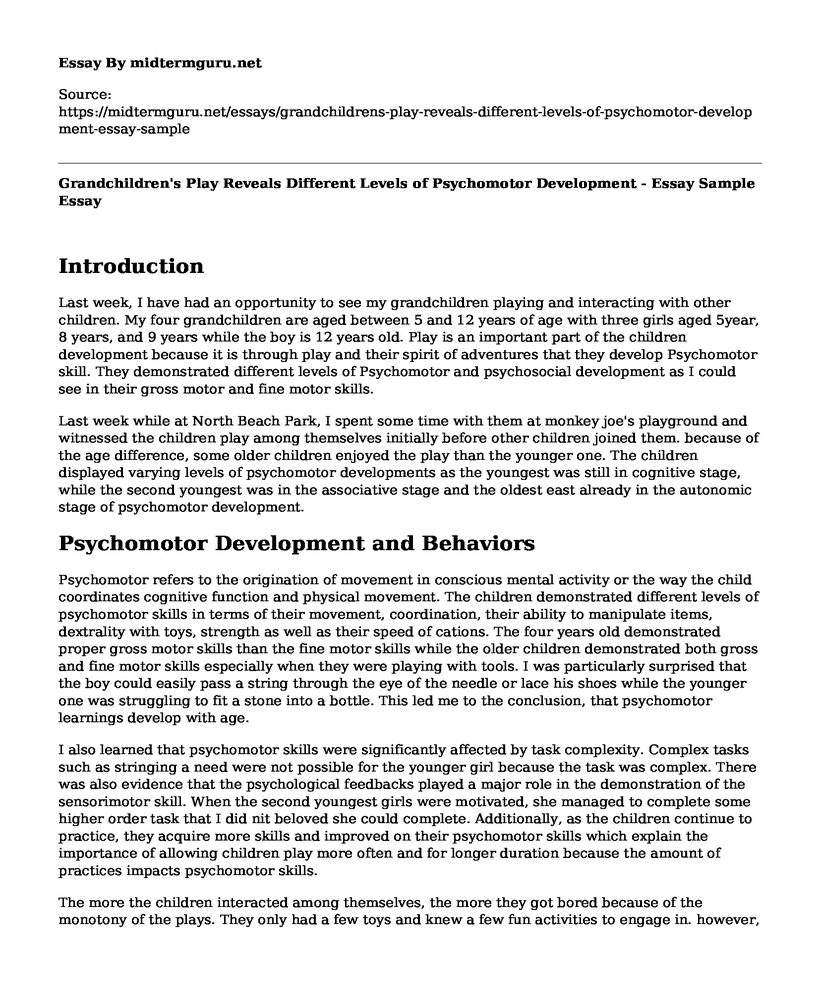Introduction
Last week, I have had an opportunity to see my grandchildren playing and interacting with other children. My four grandchildren are aged between 5 and 12 years of age with three girls aged 5year, 8 years, and 9 years while the boy is 12 years old. Play is an important part of the children development because it is through play and their spirit of adventures that they develop Psychomotor skill. They demonstrated different levels of Psychomotor and psychosocial development as I could see in their gross motor and fine motor skills.
Last week while at North Beach Park, I spent some time with them at monkey joe's playground and witnessed the children play among themselves initially before other children joined them. because of the age difference, some older children enjoyed the play than the younger one. The children displayed varying levels of psychomotor developments as the youngest was still in cognitive stage, while the second youngest was in the associative stage and the oldest east already in the autonomic stage of psychomotor development.
Psychomotor Development and Behaviors
Psychomotor refers to the origination of movement in conscious mental activity or the way the child coordinates cognitive function and physical movement. The children demonstrated different levels of psychomotor skills in terms of their movement, coordination, their ability to manipulate items, dextrality with toys, strength as well as their speed of cations. The four years old demonstrated proper gross motor skills than the fine motor skills while the older children demonstrated both gross and fine motor skills especially when they were playing with tools. I was particularly surprised that the boy could easily pass a string through the eye of the needle or lace his shoes while the younger one was struggling to fit a stone into a bottle. This led me to the conclusion, that psychomotor learnings develop with age.
I also learned that psychomotor skills were significantly affected by task complexity. Complex tasks such as stringing a need were not possible for the younger girl because the task was complex. There was also evidence that the psychological feedbacks played a major role in the demonstration of the sensorimotor skill. When the second youngest girls were motivated, she managed to complete some higher order task that I did nit beloved she could complete. Additionally, as the children continue to practice, they acquire more skills and improved on their psychomotor skills which explain the importance of allowing children play more often and for longer duration because the amount of practices impacts psychomotor skills.
The more the children interacted among themselves, the more they got bored because of the monotony of the plays. They only had a few toys and knew a few fun activities to engage in. however, when they were joined by other children, their energy rejuvenated as they learned new ideas, most likely of increasing complexity. I learned that children want diversity in their fun activity. The newer activities were introduced the more they continued to play. At this point, I realized the role of motive incentive conditions. Some motive incentive condition has a significant effect on the learning as well as performances of some psychomotor tasks. Instructors can also modify the children's proficiency in their fine and gross motor performances. This proves the theory of environmental stimulation on psychomotor performance.
Psychosocial Development and Behaviors
The psychosocial development is seen in the children also helped in proving the arguments postulated by Erik Erikson's Stages of Psychosocial Development. The children had passed the dependent stage of development and could easily play with others including strangers. The chore had already learned how to trust other children but was cautious of the adults they considered strangers. The chordal also showed a higher level of self-control. The younger child decided not to play with other children and even shunned their toys which proved that at age five, she could control her impulses. She felt secure playing with her brothers and sister. She was also confident to try the activities that the others were engaged in. however, as the tax complexity increase, she started to think about the next movements before engaging in such movement while the boy moved from one place to another, one game to another game without thinking probably because of the autonomy stage he was in. Most of the psychosocial behavers are usually directed towards the people around the children or the society that is why I saw predation behaviors in the eight years old.
Conclusion
There are some instructional techniques that support psychomotor and psychosocial development in children. It is, therefore, important to adopt age and culturally appropriate instructions and fun activities for the children. psychomotor and psychosocial behaviors in children vary with age. As they grow, they tend to become independent. Any conflicts between the children need for independent functional, and self-identity and the parent's expectation, attitudes and controls lead to problems with the child. I realized that the psychosocial milestones depending on the temperament of the child which is also remotely associated with the parenting style.
Cite this page
Grandchildren's Play Reveals Different Levels of Psychomotor Development - Essay Sample. (2023, Jan 27). Retrieved from https://midtermguru.com/essays/grandchildrens-play-reveals-different-levels-of-psychomotor-development-essay-sample
If you are the original author of this essay and no longer wish to have it published on the midtermguru.com website, please click below to request its removal:
- Essay on Black Lives Matter Movement and Increase of Crime Rate
- Intrinsic Aspects of the Language - Essay Sample
- How State and Society Changed Modern Middle Eastern History - Essay Sample
- The Coddling of the American Mind - Article Analysis Essay
- Depression: A Combination of Psychological, Social and Biological Factors - Essay Sample
- Effective Communication: Key to Successful Teaching & Learning - Essay Sample
- Essay Sample on Sequence and Rates of Development







